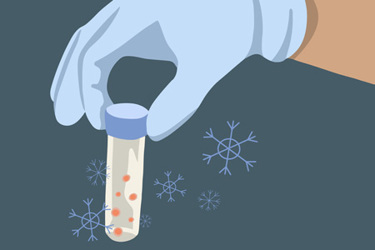What COVID-19 Taught Us About Fresh Vs. "Frozen" Allogeneic HSC Grafts
A conversation with Steven Devine, MD, chief medical officer of National Marrow Donor Program (NMDP)/Be The Match and senior scientific director of the Center for International Blood and Marrow Transplant Research (CIBMTR)

Until now, the impact of cryopreservation on hematopoietic stem cell (HSC) grafts has been elusive. But a recent observational study of both adult and pediatric patients receiving their first hematopoietic cell transplantation (HCT) from a related or unrelated donor has revealed the intricacies at play when comparing fresh versus “frozen” allogeneic hematopoietic cell grafts in treating malignant and non-malignant disease.
Comparing data from grafts conducted during the COVID-19 pandemic, when cryopreservation proved most useful, to the more recent use of fresh transplants, Steven Devine, MD, chief medical officer of National Marrow Donor Program (NMDP)/Be The Match and senior scientific director of the Center for International Blood and Marrow Transplant Research (CIBMTR), came to a reassuring conclusion. Here, he discusses the observational study and its implications for clinical trials.
Clinical Leader: Fresh allogeneic grafts have been the norm — up until the COVID-19 pandemic. What did you understand about cryopreservation until that point? And what did you hope to learn in studying the two options?
Steven Devine, MD: The impact of graft cryopreservation on allogeneic transplant is not well understood. Traditionally, allogeneic grafts are infused fresh, within 48 hours of collection. Cryopreservation was generally reserved for circumstances when that timeline could not be met due to patient, donor, or logistical issues. This lack of a unifying rationale for cryopreservation made prior historical comparisons between fresh and cryopreserved difficult to interpret.
For example, CIBMTR completed three retrospective analyses of outcomes in recipients of cryopreserved compared to fresh grafts, each showing differential effects of cryopreservation on outcomes based on underlying disease and transplant approach.
One study focused on transplantation for severe aplastic anemia found that cryopreservation was associated with high rates of graft failure. Another study in haploidentical transplants for malignant disease using post-transplant cyclophosphamide graft versus host disease (GVHD) prophylaxis noted no differences between fresh and cryopreserved grafts. The last study of a large cohort of patients receiving allogeneic transplant using predominately calcineurin inhibitor based GVHD prophylaxis noted adverse effects of cryopreservation on overall survival using peripheral blood stem cell grafts. However, this occurred in the setting of mainly unplanned cryopreservation. In a small subset analysis of cases where the rationale for cryopreservation was reported, patient-related factors, such as disease progression and infection, proved to be the impetus and thus made the results difficult to interpret.
The COVID pandemic necessitated a rapid change in practice, leading to an increased use of cryopreserved HSC grafts from related and unrelated donors. Cryopreservation proved necessary because of the increased logistical challenges from international travel bans, unpredictable domestic flight schedules, and fluctuating donor availability due to COVID exposures. NMDP/Be The Match mandated cryopreservation for its facilitated collections at the start of the pandemic to ensure patients had a graft available before the start of conditioning for HCT. Many transplant centers adopted a similar approach for locally collected products.
This unprecedented and rapid shift to planned cryopreservation provided a unified rationale for using cryopreserved grafts. It also facilitated a comparison of outcomes for patients receiving fresh grafts prior to the pandemic to those receiving cryopreserved grafts after the mandates were implemented. To address this question, the study compared the outcomes of allogeneic donor transplants performed at U.S. transplant centers using fresh grafts from March 1, 2019, to Aug. 31, 2019, to those performed using cryopreserved grafts from March 1, 2020, to Aug. 31, 2020. The study aimed to gain more insight into the impact of cryopreservation on transplant outcomes in a time frame when planned cryopreservation was widely used across the transplant community.
What did the study find?
The study showed that cryopreserved products did not adversely affect one-year overall survival, non-relapse mortality, acute graft-versus-host disease (GVHD), or GVHD-free relapse-free survival in recipients when compared to fresh grafts, which is reassuring about the choices made to mandate cryopreservation at the outset of the pandemic.
However, the study did find an adverse impact of cryopreservation on disease-free survival due to a higher risk of relapse. In addition, cryopreserved peripheral blood stem cell grafts had a slightly delayed time to neutrophil and platelet engraftment amounting to a one- and two-day delay, respectively. Risks of primary and secondary graft failure were slightly higher in the cryopreserved group. One positive impact of cryopreservation was an observed decrease in the risk of chronic GVHD, which a study¹ from the Dana-Farber Cancer Institute research team also reported. The association with reduced chronic GVHD is intriguing and is currently under investigation by the CIBMTR GVHD Working Committee.
What do the findings mean for clinical trials and patients?
Due to the cryopreservation requirements imposed during the pandemic, many ongoing clinical trials incorporated the use of cryopreservation to ensure timely delivery of life-saving grafts. The results from this study suggest that any impact on outcomes for the participating patients and the trial results due to use of cryopreserved grafts was minimal. In fact, the ability to rapidly pivot to use cryopreservation as a means to continue to enrollment in clinical trials benefited patients by ensuring timely access to potentially life-saving care.
How does the preference for fresh hematopoietic stem cell (HSC) grafts affect clinical trial design?
The preference is just that, a preference. The stem cell source and any manipulation of the product, such as cryopreservation, should be considered within the context of the primary aims of the study. Trials where the stem cell product is not the primary investigational intervention should consider the implications of using fresh and cryopreserved products and make a determination about inclusion in the trial design. In a setting where the graft is the primary intervention, e.g., graft engineering, it would be important to consider the product manufacturing process and whether use of fresh and/or cryopreserved grafts yields equivalent products. In the end, it depends on the planned intervention and any potential impact of differences reported in the performance of fresh and cryopreserved grafts on the endpoints of the study.
Understanding the preference for HSC grafts, what clinical trial design and supply chain challenges need to be addressed — especially as pharmas continue to design trials with disruptive global events in mind?
The preference for fresh grafts needs to be considered in the context of the goals of the trial as whole. If fresh products are an absolute requirement, then contingency plans should be developed to ensure that access to fresh products can be maintained in the event of a disruption. Working closely with donor registries during the trial design process would be critical for the development of such contingency plans.
Are there any limitations to the study that should be noted?
There are several limitations to the study that are worthy of note. The data analyzed were collected retrospectively and dependent on individual center reporting to the CIBMTR. While the data is quite complete overall, there may be patients in both time periods who were not reported and therefore were excluded from the analysis. The data completeness was lower in the cryopreserved group potentially due to staffing limitations during and after the pandemic. Regardless, the data are quite representative of the U.S. transplant experience prior to and following the onset of the pandemic, with 77 centers represented in the analysis. The study did not collect or include any detailed information on the cryopreservation methods used or post-thaw product evaluations. Also, limited data was available on the individual product transit times from the collection to transplant center, so collection center location, e.g., U.S. vs. international, was used as a surrogate for longer transit times. Lastly, the follow-up on the cohort was limited to one year, so evaluation of longer-term outcomes may be warranted.
Understanding the consequences of the COVID-19 pandemic, this study also illustrates how adversity brings about innovation. What else have you learned from this experience?
The pandemic was obviously problematic for many reasons; however, it provided a unique opportunity to explore the use of fresh vs. cryopreserved grafts for allogeneic transplantation. These results provide a better understanding of the impact of cryopreservation and offer some guidance on how to counsel patients on how planned cryopreservation may impact the course of care. There are still additional questions to be answered on the topic, including the longer-term impacts and potential mechanisms underlying the differences in outcomes. These topics are worthy of investigation in the future.
References:
- Maurer K, Kim HT, Garrity HM, Liney D, Cutler C, Antin JH, Koreth J, Ritz J, Shapiro RM, Romee R, Ho VT, Gooptu M, Soiffer RJ, Wu CJ, Nikiforow S. Lower incidence of chronic GVHD observed after transplantation with cryopreserved unrelated allogeneic stem cells. Blood Adv. 2023 Jun 13;7(11):2431-2435. doi: 10.1182/bloodadvances.2022009231. PMID: 36595453; PMCID: PMC10241844.
About The Expert:
 Steven Devine, MD, is chief medical officer of National Marrow Donor Program (NMDP)/Be The Match and senior scientific director of the Center for International Blood and Marrow Transplant Research (CIBMTR). Devine is a global influencer in the field of hematopoietic cell transplantation (HCT). He is a board-certified adult medical oncologist. Before joining NMDP/Be The Match, he was a professor of medicine and director of the BMT Program at The Ohio State University Comprehensive Cancer Center. He has led NIH-funded clinical trials groups, including eight years as chair of the National Cancer Institute-funded Alliance Transplant Committee and a two-year term as chair of the Blood and Marrow Transplant Clinical Trials Network (BMT CTN) Steering Committee.
Steven Devine, MD, is chief medical officer of National Marrow Donor Program (NMDP)/Be The Match and senior scientific director of the Center for International Blood and Marrow Transplant Research (CIBMTR). Devine is a global influencer in the field of hematopoietic cell transplantation (HCT). He is a board-certified adult medical oncologist. Before joining NMDP/Be The Match, he was a professor of medicine and director of the BMT Program at The Ohio State University Comprehensive Cancer Center. He has led NIH-funded clinical trials groups, including eight years as chair of the National Cancer Institute-funded Alliance Transplant Committee and a two-year term as chair of the Blood and Marrow Transplant Clinical Trials Network (BMT CTN) Steering Committee.
